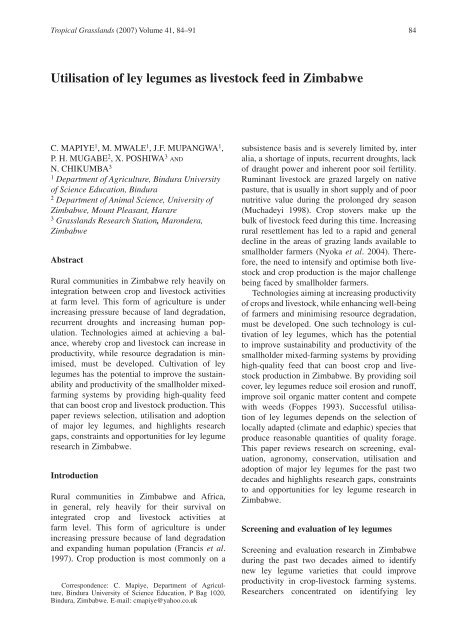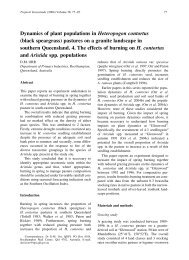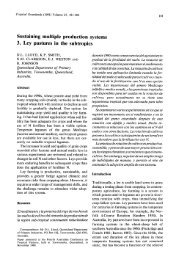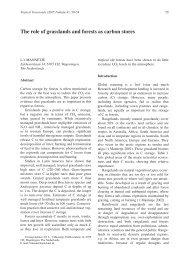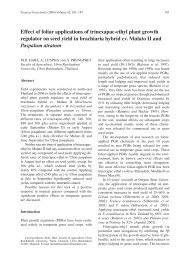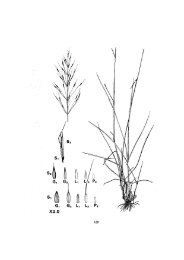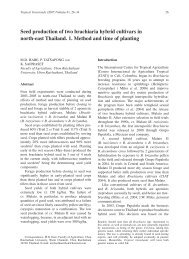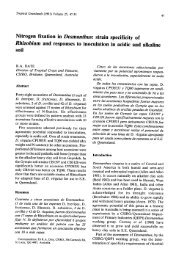Utilisation of ley legumes as livestock feed in Zimbabwe - Tropical ...
Utilisation of ley legumes as livestock feed in Zimbabwe - Tropical ...
Utilisation of ley legumes as livestock feed in Zimbabwe - Tropical ...
Create successful ePaper yourself
Turn your PDF publications into a flip-book with our unique Google optimized e-Paper software.
<strong>Tropical</strong> Gr<strong>as</strong>slands (2007) Volume 41, 84–91 84<br />
<strong>Utilisation</strong> <strong>of</strong> <strong>ley</strong> <strong>legumes</strong> <strong>as</strong> <strong>livestock</strong> <strong>feed</strong> <strong>in</strong> <strong>Zimbabwe</strong><br />
C. MAPIYE 1 , M. MWALE 1 , J.F. MUPANGWA 1 ,<br />
P. H. MUGABE 2 , X. POSHIWA 3 AND<br />
N. CHIKUMBA 3<br />
1<br />
Department <strong>of</strong> Agriculture, B<strong>in</strong>dura University<br />
<strong>of</strong> Science Education, B<strong>in</strong>dura<br />
2<br />
Department <strong>of</strong> Animal Science, University <strong>of</strong><br />
<strong>Zimbabwe</strong>, Mount Ple<strong>as</strong>ant, Harare<br />
3<br />
Gr<strong>as</strong>slands Research Station, Marondera,<br />
<strong>Zimbabwe</strong><br />
Abstract<br />
Rural communities <strong>in</strong> <strong>Zimbabwe</strong> rely heavily on<br />
<strong>in</strong>tegration between crop and <strong>livestock</strong> activities<br />
at farm level. This form <strong>of</strong> agriculture is under<br />
<strong>in</strong>cre<strong>as</strong><strong>in</strong>g pressure because <strong>of</strong> land degradation,<br />
recurrent droughts and <strong>in</strong>cre<strong>as</strong><strong>in</strong>g human population.<br />
Tech nologies aimed at achiev<strong>in</strong>g a balance,<br />
whereby crop and <strong>livestock</strong> can <strong>in</strong>cre<strong>as</strong>e <strong>in</strong><br />
productivity, while resource degradation is m<strong>in</strong>imised,<br />
must be developed. Cultivation <strong>of</strong> <strong>ley</strong><br />
<strong>legumes</strong> h<strong>as</strong> the potential to improve the susta<strong>in</strong>ability<br />
and produc tivity <strong>of</strong> the smallholder mixedfarm<strong>in</strong>g<br />
systems by provid<strong>in</strong>g high-quality <strong>feed</strong><br />
that can boost crop and <strong>livestock</strong> production. This<br />
paper reviews selection, utilisation and adoption<br />
<strong>of</strong> major <strong>ley</strong> <strong>legumes</strong>, and highlights research<br />
gaps, constra<strong>in</strong>ts and opportunities for <strong>ley</strong> legume<br />
research <strong>in</strong> <strong>Zimbabwe</strong>.<br />
Introduction<br />
Rural communities <strong>in</strong> <strong>Zimbabwe</strong> and Africa,<br />
<strong>in</strong> general, rely heavily for their survival on<br />
<strong>in</strong>tegrated crop and <strong>livestock</strong> activities at<br />
farm level. This form <strong>of</strong> agriculture is under<br />
<strong>in</strong>cre<strong>as</strong><strong>in</strong>g pressure because <strong>of</strong> land degradation<br />
and expand<strong>in</strong>g human population (Francis et al.<br />
1997). Crop production is most commonly on a<br />
Correspondence: C. Mapiye, Department <strong>of</strong> Agriculture,<br />
B<strong>in</strong>dura University <strong>of</strong> Science Education, P Bag 1020,<br />
B<strong>in</strong>dura, <strong>Zimbabwe</strong>. E-mail: cmapiye@yahoo.co.uk<br />
subsistence b<strong>as</strong>is and is severely limited by, <strong>in</strong>ter<br />
alia, a shortage <strong>of</strong> <strong>in</strong>puts, recurrent droughts, lack<br />
<strong>of</strong> draught power and <strong>in</strong>herent poor soil fertility.<br />
Rum<strong>in</strong>ant <strong>livestock</strong> are grazed largely on native<br />
p<strong>as</strong>ture, that is usually <strong>in</strong> short supply and <strong>of</strong> poor<br />
nutritive value dur<strong>in</strong>g the prolonged dry se<strong>as</strong>on<br />
(Muchadeyi 1998). Crop stovers make up the<br />
bulk <strong>of</strong> <strong>livestock</strong> <strong>feed</strong> dur<strong>in</strong>g this time. Incre<strong>as</strong><strong>in</strong>g<br />
rural resettlement h<strong>as</strong> led to a rapid and general<br />
decl<strong>in</strong>e <strong>in</strong> the are<strong>as</strong> <strong>of</strong> graz<strong>in</strong>g lands available to<br />
smallholder farmers (Nyoka et al. 2004). Therefore,<br />
the need to <strong>in</strong>tensify and optimise both <strong>livestock</strong><br />
and crop production is the major challenge<br />
be<strong>in</strong>g faced by smallholder farmers.<br />
Technologies aim<strong>in</strong>g at <strong>in</strong>cre<strong>as</strong><strong>in</strong>g productivity<br />
<strong>of</strong> crops and <strong>livestock</strong>, while enhanc<strong>in</strong>g well-be<strong>in</strong>g<br />
<strong>of</strong> farmers and m<strong>in</strong>imis<strong>in</strong>g resource degradation,<br />
must be developed. One such technology is cultivation<br />
<strong>of</strong> <strong>ley</strong> <strong>legumes</strong>, which h<strong>as</strong> the potential<br />
to improve susta<strong>in</strong>ability and productivity <strong>of</strong> the<br />
smallholder mixed-farm<strong>in</strong>g systems by provid<strong>in</strong>g<br />
high-quality <strong>feed</strong> that can boost crop and <strong>livestock</strong><br />
production <strong>in</strong> <strong>Zimbabwe</strong>. By provid<strong>in</strong>g soil<br />
cover, <strong>ley</strong> <strong>legumes</strong> reduce soil erosion and run<strong>of</strong>f,<br />
improve soil organic matter content and compete<br />
with weeds (Foppes 1993). Successful utilisation<br />
<strong>of</strong> <strong>ley</strong> <strong>legumes</strong> depends on the selection <strong>of</strong><br />
locally adapted (climate and edaphic) species that<br />
produce re<strong>as</strong>onable quantities <strong>of</strong> quality forage.<br />
This paper reviews research on screen<strong>in</strong>g, evaluation,<br />
agronomy, conservation, utilisation and<br />
adoption <strong>of</strong> major <strong>ley</strong> <strong>legumes</strong> for the p<strong>as</strong>t two<br />
decades and highlights research gaps, constra<strong>in</strong>ts<br />
to and opportunities for <strong>ley</strong> legume research <strong>in</strong><br />
<strong>Zimbabwe</strong>.<br />
Screen<strong>in</strong>g and evaluation <strong>of</strong> <strong>ley</strong> <strong>legumes</strong><br />
Screen<strong>in</strong>g and evaluation research <strong>in</strong> <strong>Zimbabwe</strong><br />
dur<strong>in</strong>g the p<strong>as</strong>t two decades aimed to identify<br />
new <strong>ley</strong> legume varieties that could improve<br />
productivity <strong>in</strong> crop-<strong>livestock</strong> farm<strong>in</strong>g systems.<br />
Researchers concentrated on identify<strong>in</strong>g <strong>ley</strong>
<strong>Utilisation</strong> <strong>of</strong> <strong>ley</strong> <strong>legumes</strong> <strong>in</strong> <strong>Zimbabwe</strong> 85<br />
<strong>legumes</strong> that would be ideal for cereal-legume<br />
<strong>in</strong>tercropp<strong>in</strong>g systems. Substantial evidence<br />
h<strong>as</strong> been accumulated to show that <strong>ley</strong> farm<strong>in</strong>g<br />
is both fe<strong>as</strong>ible and potentially very beneficial<br />
for <strong>Zimbabwe</strong> (Muchadeyi 1998; Jiri 2003;<br />
Ma<strong>as</strong>dorp et al. 2004). However, there are few<br />
examples <strong>of</strong> legume-b<strong>as</strong>ed <strong>ley</strong> farm<strong>in</strong>g systems<br />
that have been readily adopted by farmers <strong>in</strong><br />
<strong>Zimbabwe</strong>. Three species, namely: Lablab purpureus<br />
(lablab), Mucuna pruriens (velvet bean)<br />
and Vigna unguiculata (cowpea), have been successfully<br />
established, ma<strong>in</strong>ly to <strong>feed</strong> dairy cattle<br />
under different climatic and management conditions<br />
(Majee and Chikumba 1995; Muchadeyi<br />
1998; Nyoka et al. 2004) (Table 1). Crotalaria<br />
juncea (sunnhemp), Glyc<strong>in</strong>e max (soybean)<br />
Vicia sativa (vetch), Pisum sativum (pea) and<br />
Lup<strong>in</strong>us albus (white lup<strong>in</strong>) have been used to<br />
a lesser extent, and research on these species<br />
<strong>in</strong> <strong>Zimbabwe</strong> is limited. Despite little attention<br />
be<strong>in</strong>g given to the afore-mentioned species, they<br />
have shown a lot <strong>of</strong> potential <strong>in</strong> other tropical<br />
countries (Muchadeyi 1998). Hence, there is need<br />
to broaden the research agenda to <strong>in</strong>clude selection<br />
<strong>of</strong> these species, especially <strong>in</strong> smallholder<br />
are<strong>as</strong> <strong>of</strong> low agricultural potential.<br />
The follow<strong>in</strong>g attributes were used for<br />
screen <strong>in</strong>g and evaluation: e<strong>as</strong>e <strong>of</strong> establishment<br />
(high seed-production potential); e<strong>as</strong>e <strong>of</strong> reestablishment<br />
(high soil-seed-reserve potential,<br />
hardseededness); longevity; e<strong>as</strong>e <strong>of</strong> control dur<strong>in</strong>g<br />
the crop ph<strong>as</strong>e; high nitrogen-fixation potential (a<br />
function <strong>of</strong> plant productivity and soil adaptation);<br />
drought tolerance; tolerance <strong>of</strong> dise<strong>as</strong>es and pests;<br />
chemical composition; and animal production (a<br />
function <strong>of</strong> plant production and nutritive value)<br />
(Clatworthy and Madakadze 1988; Mutisi et al.<br />
1994). The selection criteria should be extended<br />
to <strong>in</strong>clude important parameters such <strong>as</strong>: nutrient<br />
uptake efficiency; species complementarity (<strong>as</strong>sociative<br />
ability); economics <strong>of</strong> <strong>ley</strong> legume production;<br />
and animal production factors such <strong>as</strong> <strong>in</strong> vivo<br />
digestibility, <strong>in</strong> vivo degradability and effects on<br />
milk yield, reproduction and growth rates.<br />
Gr<strong>as</strong>slands Research Station <strong>in</strong> Marondera<br />
identified Lablab purpureus cvv. Rongai and<br />
Highworth and ILCA Acc. 11642 <strong>as</strong> appropriate<br />
<strong>legumes</strong> for <strong>in</strong>tercropp<strong>in</strong>g <strong>in</strong> the high- potential<br />
agro-ecological communal are<strong>as</strong> <strong>of</strong> <strong>Zimbabwe</strong><br />
(Manyawu et al. 1993; Manyawu 1998). Grown<br />
alone, Rongai and Jhansi gave the highest forage<br />
yields (5.9 and 5.85 t/ha DM) and were ideal<br />
for use <strong>as</strong> annual or bi-annual fodder banks<br />
(Manyawu et al. 1993; J<strong>in</strong>gura et al. 2001). However,<br />
Highworth produced the highest gra<strong>in</strong> and<br />
forage yields <strong>in</strong> semi-arid agro-ecological zones<br />
<strong>of</strong> <strong>Zimbabwe</strong> (Mutisi et al. 1994). In order to<br />
realise full benefits from lablab, there is a need to<br />
control dise<strong>as</strong>es and pests (aphids and cutworms)<br />
(Manyawu et al. 1993). Therefore, it is important<br />
to select lablab accessions for resistance to not<br />
only bacterial and fungal dise<strong>as</strong>es but also pest<br />
attack.<br />
Prelim<strong>in</strong>ary f<strong>in</strong>d<strong>in</strong>gs from on-farm research <strong>in</strong><br />
Chihota communal lands and Makaholi Research<br />
Station <strong>in</strong>dicated that Mucuna pruriens and Vigna<br />
unguiculata produced high yields <strong>in</strong> warmer and<br />
medium-high ra<strong>in</strong>fall are<strong>as</strong> with poor soil fertility<br />
<strong>in</strong> <strong>Zimbabwe</strong> (Majee and Chikumba 1995;<br />
Jiri 2003) (Table 1). Vigna unguiculata accession<br />
121688 gave the highest forage dry matter yield<br />
(2.38 t/ha) after one se<strong>as</strong>on’s growth <strong>in</strong> studies<br />
conducted <strong>in</strong> Hwedza (Manyawu 1998; Mur<strong>in</strong>gweni<br />
et al. 2004).<br />
Selection <strong>of</strong> tropical <strong>legumes</strong> for <strong>ley</strong>s h<strong>as</strong> concentrated<br />
largely on the three above-mentioned<br />
species rather than on systematic screen<strong>in</strong>g <strong>of</strong><br />
large germpl<strong>as</strong>m collections for suitability <strong>as</strong><br />
<strong>ley</strong>s. Thus, it is suggested that screen<strong>in</strong>g and<br />
evaluation programs should be expanded to<br />
<strong>in</strong>clude accessions/cultivars <strong>of</strong> <strong>legumes</strong> that are<br />
more efficient and require fewer establishment<br />
and management <strong>in</strong>puts than exist<strong>in</strong>g species and<br />
cultivars. Different germpl<strong>as</strong>m options should<br />
Table 1. Climatic and edaphic attributes <strong>of</strong> common <strong>ley</strong> legume species and cultivars used <strong>in</strong> crop-<strong>livestock</strong> systems <strong>in</strong> <strong>Zimbabwe</strong>.<br />
Species Common name Common cultivars Soil type Ra<strong>in</strong>fall (mm) Temperature (°C)<br />
Lablab purpureus Lablab Rongai, Highworth Deep sands to heavy clays
86 C. Mapiye et al.<br />
be considered, <strong>in</strong>clud<strong>in</strong>g those developed for<br />
different environments <strong>in</strong> terms <strong>of</strong> soil, climate<br />
and production systems. In addition to a wider<br />
species range, evaluation <strong>of</strong> <strong>legumes</strong> should be<br />
b<strong>as</strong>ed on an <strong>in</strong>tra-specific variability <strong>as</strong> broad <strong>as</strong><br />
possible.<br />
Longevity <strong>of</strong> the species is another important<br />
consideration. Although the concept <strong>of</strong> a shortterm<br />
<strong>ley</strong> almost implies that the respective legume<br />
is short-lived, persistent legume banks or mixed<br />
p<strong>as</strong>tures with high legume content should also be<br />
considered. In comparison with annuals, longerlived<br />
<strong>legumes</strong> will have an important advantage<br />
dur<strong>in</strong>g the dry se<strong>as</strong>on. In this context, a potential<br />
option that should be researched is that <strong>of</strong> mixtures<br />
<strong>of</strong> complementary legume species. Possible<br />
topics for future research are <strong>as</strong> follows: characterisation<br />
<strong>of</strong> the potential <strong>of</strong> soil seed reserves<br />
and seedl<strong>in</strong>g recruitment; break<strong>in</strong>g <strong>of</strong> pest and<br />
dise<strong>as</strong>e cycles through legume <strong>ley</strong>s; and me<strong>as</strong>urement<br />
<strong>of</strong> animal production on legume <strong>ley</strong>s (very<br />
limited data currently available).<br />
Agronomy <strong>of</strong> <strong>ley</strong> <strong>legumes</strong><br />
Ley legume experiments were conducted to provide<br />
additional <strong>in</strong>formation on the management<br />
<strong>of</strong> new p<strong>as</strong>ture species that would have succeeded<br />
<strong>in</strong> evaluation trials. At Gr<strong>as</strong>slands, it w<strong>as</strong><br />
established that lablab, cowpea and velvet bean<br />
should be planted with the first ra<strong>in</strong>s <strong>in</strong> October–<br />
November <strong>in</strong> order to maximise herbage yield.<br />
Velvet bean, cowpea and lablab are best sown<br />
<strong>in</strong>to a well prepared, fallowed seedbed that h<strong>as</strong> a<br />
good depth <strong>of</strong> subsoil moisture (at le<strong>as</strong>t 60 cm).<br />
Seed should be sown at a depth <strong>of</strong> 5–10 cm <strong>in</strong>to<br />
moist soil with good seed-soil contact. For pure<br />
stands, the <strong>in</strong>ter-row and <strong>in</strong>tra-row spac<strong>in</strong>gs<br />
should range from 60–100 cm and 20–75 cm,<br />
respectively. The average seed<strong>in</strong>g rates for velvet<br />
bean, cowpea and lablab are 20–30, 10–20 and<br />
15–25 kg/ha, respectively. Normally, one seed<br />
per station is allowed, because the germ<strong>in</strong>ation<br />
rate is very good (75–95%) for seed, which h<strong>as</strong><br />
been less than 18 months <strong>in</strong> storage. These <strong>ley</strong><br />
<strong>legumes</strong> are <strong>in</strong>oculated with cowpea rhizobium,<br />
and lime is applied at a rate <strong>of</strong> 500–1000 kg/<br />
ha before plant<strong>in</strong>g. B<strong>as</strong>al applications <strong>of</strong> s<strong>in</strong>gle<br />
superphosphate at a rate <strong>of</strong> 150–300 kg/ha and<br />
pot<strong>as</strong>sium (K) <strong>as</strong> muriate <strong>of</strong> pot<strong>as</strong>h at a rate <strong>of</strong><br />
40–200 mg/kg before or at plant<strong>in</strong>g are recommended<br />
(Muchadeyi 1998). It w<strong>as</strong> also shown<br />
that it is best to harvest lablab once (May–June)<br />
for optimum herbage yield (Manyawu 1998).<br />
Results <strong>of</strong> <strong>in</strong>tercropp<strong>in</strong>g research over the p<strong>as</strong>t<br />
two decades favoured the simultaneous plant<strong>in</strong>g<br />
<strong>of</strong> <strong>ley</strong> <strong>legumes</strong> (velvet bean, cowpea and lablab)<br />
with maize, napier/bana gr<strong>as</strong>s, millet or sorghum,<br />
except where the legume can be too vigorous for<br />
the companion crop (Muchadeyi 1998; Nyoka<br />
et al. 2004). Intercropp<strong>in</strong>g with <strong>legumes</strong> <strong>in</strong>cre<strong>as</strong>ed<br />
herbage yield by 40–60%, although the cereal<br />
gra<strong>in</strong> yields were depressed by up to 20%. When<br />
velvet bean is mixed with gr<strong>as</strong>ses or cereals, the<br />
yield <strong>of</strong> cereals is naturally depressed to below<br />
10 t/ha. However, the total yields depend on plant<br />
populations, quality <strong>of</strong> the se<strong>as</strong>on and the management<br />
systems employed (Muza 1998). Lablab<br />
should be sown about 28 days after the maize<br />
crop h<strong>as</strong> been planted to avoid severe depression<br />
<strong>in</strong> cereal crop yield from competition. Where<br />
lablab precedes maize <strong>in</strong> a rotation, nitrogen fertiliser<br />
application can be reduced to 75% <strong>of</strong> the<br />
recommended levels <strong>in</strong> the subsequent maize<br />
crop (Muchadeyi 1998). In on-farm trials <strong>in</strong> the<br />
Hwedza communal area <strong>of</strong> <strong>Zimbabwe</strong>, varieties<br />
<strong>of</strong> velvet bean and lablab were found to improve<br />
the maize crop <strong>in</strong> the follow<strong>in</strong>g year by up to<br />
3 t/ha, compared with a ‘weed fallow’ before<br />
sow<strong>in</strong>g the maize (Jiri 2003). Future research on<br />
the economics (costs and benefits) <strong>of</strong> us<strong>in</strong>g <strong>ley</strong><br />
<strong>legumes</strong> is essential to allow farmers to make<br />
<strong>in</strong>formed decisions relat<strong>in</strong>g to <strong>in</strong>put costs and<br />
production benefits.<br />
Conservation and utilisation <strong>of</strong> <strong>ley</strong> <strong>legumes</strong><br />
Velvet bean<br />
Feed<strong>in</strong>g value. In <strong>Zimbabwe</strong>, velvet bean is used<br />
<strong>as</strong> green manure and for cattle <strong>feed</strong>, <strong>as</strong> mature<br />
pods, hay, ensilage with mol<strong>as</strong>ses, maize-Mucuna<br />
silage or graz<strong>in</strong>g (Jiri 2003). Dry matter (DM) production<br />
is high, reach<strong>in</strong>g 9–12 t/ha <strong>in</strong> a 900 mm<br />
ra<strong>in</strong>fall region <strong>in</strong> <strong>Zimbabwe</strong> (Muchadeyi 1998).<br />
Fresh velvet bean is <strong>of</strong> good quality (Table 2)<br />
with an average <strong>of</strong> 23% crude prote<strong>in</strong> (CP) and<br />
82% total digestible nutrients (TDN) (Topps and<br />
Oliver 1993; Muchadeyi 1998). Ma<strong>as</strong>dorp and Titterton<br />
(1997) reported CP concentration <strong>of</strong> 182 g/<br />
kg DM <strong>in</strong> Mucuna forage <strong>in</strong> <strong>Zimbabwe</strong> at peak<br />
biom<strong>as</strong>s yield (also peak digestible dry matter<br />
yield) at the early green pod stage. These results<br />
were comparable with those for lablab (164 g/kg)
<strong>Utilisation</strong> <strong>of</strong> <strong>ley</strong> <strong>legumes</strong> <strong>in</strong> <strong>Zimbabwe</strong> 87<br />
and cowpea (200 g/kg). However, velvet bean is<br />
unpalatable to most <strong>livestock</strong>, despite an average<br />
digestibility <strong>of</strong> about 65%. S<strong>in</strong>ce Mucuna h<strong>as</strong><br />
high nutritive value, it would seem desirable to<br />
embark on research to improve its palatability.<br />
Table 2. Nutritive value <strong>of</strong> velvet bean.<br />
Component Nutrient Concentration<br />
Seed meal Crude prote<strong>in</strong> (%) 23.0<br />
Digestible prote<strong>in</strong> (%) 19.0<br />
Seed meal hay Crude prote<strong>in</strong> (%) 23.5<br />
ADF (%) 10.7<br />
Hay Crude prote<strong>in</strong> (%) 14–21<br />
ADF (%) 36.3<br />
Seed Prote<strong>in</strong> (%) 25.5<br />
Digestible prote<strong>in</strong> (%) 21.1<br />
Total digestible nutrients (%) 91.1<br />
Fibre (%) 12–15<br />
ME (MJ/kg at 90% DM) 12.1<br />
Whole pod Prote<strong>in</strong> (%) 20.0<br />
Digestible prote<strong>in</strong> (%) 14.4<br />
Total digestible nutrients (%) 82.2<br />
Fibre (%) 13.0<br />
ME (MJ/kg at 90% DM) 11.0<br />
Source: Muchadeyi 1998; Topps and Oliver 1993.<br />
Both whole and ground pods are unpalatable<br />
(Topps and Oliver 1993), though gr<strong>in</strong>d<strong>in</strong>g tends to<br />
improve palatability (D’Mello 1995). S<strong>in</strong>ce pods<br />
act <strong>as</strong> a potent laxative, the quantity fed should<br />
be limited (e.g. 2 kg/d). Where gr<strong>in</strong>d<strong>in</strong>g proves<br />
<strong>in</strong>convenient, seeds or pods should be soaked for<br />
24 hours before <strong>feed</strong><strong>in</strong>g (Topps and Oliver 1993).<br />
Although cook<strong>in</strong>g Mucuna can reduce its toxicity<br />
and <strong>in</strong>cre<strong>as</strong>e its digestibility (D’Mello 1995),<br />
Topps and Oliver (1993) warn aga<strong>in</strong>st <strong>feed</strong><strong>in</strong>g it<br />
to pigs and poultry. It can cause acute vomit<strong>in</strong>g<br />
and diarrhoea on account <strong>of</strong> the L-Dopa content<br />
(3,4-dihydroxy-L-phenylalan<strong>in</strong>e), and can <strong>in</strong>hibit<br />
growth and reduce egg production <strong>in</strong> chickens.<br />
Animal production. Velvet bean hay h<strong>as</strong> been<br />
successfully substituted for dairy concentrates<br />
<strong>in</strong> <strong>Zimbabwe</strong> without decl<strong>in</strong>e <strong>in</strong> milk yield or<br />
quality and h<strong>as</strong> been recommended for this purpose<br />
(Murungweni et al. 2004). In other tropical<br />
countries, it h<strong>as</strong> been used ma<strong>in</strong>ly for prote<strong>in</strong><br />
supplementation <strong>in</strong> bov<strong>in</strong>es, sheep and goats. As<br />
an example, provid<strong>in</strong>g velvet bean <strong>as</strong> a supplement<br />
for sheep resulted <strong>in</strong> a daily liveweight ga<strong>in</strong><br />
<strong>of</strong> 60 g/animal compared with 44 g/d when commercial<br />
concentrates were fed (Ma<strong>as</strong>dorp et al.<br />
2004). In Kenya, cows fed Mucuna yielded 15%<br />
more milk than those fed the control diet alone,<br />
which consisted <strong>of</strong> maize stover ad libitum plus<br />
three kilograms <strong>of</strong> maize bran daily (Juma et al.<br />
2006).<br />
Graz<strong>in</strong>g. For dairy cows graz<strong>in</strong>g on p<strong>as</strong>ture gr<strong>as</strong>s<br />
<strong>in</strong> the communal are<strong>as</strong> <strong>of</strong> <strong>Zimbabwe</strong> (1200 mm<br />
ra<strong>in</strong>fall), Mucuna proved to be the best annual<br />
legume for late summer and autumn graz<strong>in</strong>g (mid-<br />
February to mid-May) <strong>in</strong> order to reduce concentrate<br />
<strong>feed</strong> requirements (Murungweni et al. 2004).<br />
If not grazed too heavily, Mucuna grew back sufficiently<br />
well to provide a second graz<strong>in</strong>g one<br />
month later. Smallholder farmers favour delay<strong>in</strong>g<br />
the graz<strong>in</strong>g <strong>of</strong> Mucuna until after seed collection,<br />
rather than us<strong>in</strong>g the biom<strong>as</strong>s earlier, when it is<br />
more nutritious (Ma<strong>as</strong>dorp and Titterton 1997).<br />
Hay. Small-scale farmers <strong>in</strong> <strong>Zimbabwe</strong> are reluctant<br />
to cut Mucuna for hay, <strong>as</strong> that would mean<br />
forego<strong>in</strong>g seed harvest. Mucuna is seldom used<br />
for hay, <strong>as</strong> it is difficult to handle because <strong>of</strong><br />
entangled v<strong>in</strong>es, and needs to be cut early to<br />
avoid the prolonged periods required for dry<strong>in</strong>g<br />
<strong>of</strong> the thick fleshy pods, with resultant leaf loss<br />
(Jiri 2003). A few large-scale commercial farmers<br />
<strong>in</strong>tercrop maize with Mucuna, cut and store it <strong>in</strong><br />
small stacks at maturity, then mill and <strong>feed</strong> it to<br />
cattle <strong>as</strong> required dur<strong>in</strong>g the dry se<strong>as</strong>on.<br />
Silage. Although many dairy farmers <strong>in</strong><br />
<strong>Zimbabwe</strong> currently make silage, it is predom<strong>in</strong>antly<br />
maize silage, with a CP content <strong>of</strong> only<br />
about 6–8%. Intercropp<strong>in</strong>g silage maize with<br />
Mucuna improves its nutritive value (Jiri 2003).<br />
Titterton and Ma<strong>as</strong>dorp (1997) compared mixed<br />
silages (50:50 v/v) made from maize and 15 <strong>legumes</strong>.<br />
Fermentation <strong>of</strong> the maize-Mucuna mixture<br />
<strong>in</strong> terms <strong>of</strong> NH 3<br />
:N ratio proved successful,<br />
<strong>as</strong> it did not exceed the 10–15% upper limit for<br />
legume silages (Mahanna 1994). While CP concentration<br />
<strong>of</strong> the maize-Mucuna silage (138 g/kg<br />
DM) w<strong>as</strong> second only to forage soybean (153 g/kg),<br />
the maize-Mucuna silage w<strong>as</strong> otherwise <strong>of</strong> only<br />
moderate nutritive value. Its digestibility and<br />
metabolisable energy content were 50% and<br />
8.0 MJ/kg, respectively (Mahanna 1994). Harvest<strong>in</strong>g<br />
Mucuna earlier, and wilt<strong>in</strong>g it before<br />
ensil<strong>in</strong>g, could improve the quality <strong>of</strong> silage from<br />
the maize-Mucuna mixture (Jiri 2003). Maize-<br />
Mucuna silage is useful forage for dairy cattle and<br />
other productive animals. When given to cattle at<br />
the rate <strong>of</strong> 5 kg per 100 kg body m<strong>as</strong>s (25–30%<br />
DM), silage from a maize-Mucuna <strong>in</strong>tercrop provides<br />
enough nutrients for body ma<strong>in</strong>tenance<br />
(Ma<strong>as</strong>dorp and Titterton 1997).
88 C. Mapiye et al.<br />
Lablab<br />
Lablab is a dual-purpose legume used <strong>as</strong> a fodder<br />
for graz<strong>in</strong>g and conservation <strong>in</strong> <strong>Zimbabwe</strong>, <strong>as</strong><br />
well <strong>as</strong> green manure or cover crop and <strong>in</strong> cutand-carry<br />
systems and <strong>as</strong> a concentrate <strong>feed</strong><br />
(Mutisi et al. 1994). It can be <strong>in</strong>corporated <strong>in</strong>to<br />
cereal cropp<strong>in</strong>g systems <strong>as</strong> a <strong>ley</strong> legume to<br />
address the decl<strong>in</strong>e <strong>in</strong> soil fertility and is <strong>in</strong>tercropped<br />
with maize to provide better legume/<br />
stover <strong>feed</strong> quality (Muza 1998; Jiri 2003). When<br />
used for forage <strong>in</strong> large are<strong>as</strong>, lablab is <strong>of</strong>ten<br />
sown with annual gr<strong>as</strong>s/cereals such <strong>as</strong> napier/<br />
bana gr<strong>as</strong>s, maize, sorghums and millets. In<br />
smallholder systems, lablab can be <strong>in</strong>tercropped<br />
with maize (Muchadeyi 1998).<br />
Feed<strong>in</strong>g value. Se<strong>as</strong>onal yields <strong>of</strong> 2 t/ha leaf or<br />
4 t/ha stem and leaf are common <strong>in</strong> the subhumid<br />
subtropics (J<strong>in</strong>gura et al. 2001). Leaf h<strong>as</strong> CP concentration<br />
<strong>of</strong> 21–38%, while levels are 20–28%<br />
for gra<strong>in</strong> and 7–20% for stem (Table 3). Digestibility<br />
ranges from 55–76%, commonly exceed<strong>in</strong>g<br />
60% (leaves) (Muchadeyi 1998). Gra<strong>in</strong> conta<strong>in</strong>s<br />
tann<strong>in</strong>s, and phytate and tryps<strong>in</strong> <strong>in</strong>hibitors,<br />
but soak<strong>in</strong>g or cook<strong>in</strong>g reduces the activity<br />
<strong>of</strong> these compounds (Topps and Oliver 1993;<br />
D’Mello 1995).<br />
Animal production. Supplement<strong>in</strong>g the diet <strong>of</strong> sheep<br />
and goats with lablab <strong>in</strong> <strong>Zimbabwe</strong> can improve<br />
condition <strong>of</strong> does and ewes, and <strong>in</strong>cre<strong>as</strong>e birth<br />
weights and growth rates <strong>of</strong> kids <strong>as</strong> well <strong>as</strong> milk<br />
yields (Mutisi et al. 1994; Ndlovu and Sibanda<br />
1996; Titterton and Ma<strong>as</strong>dorp 1997). In Brazil,<br />
zebu cattle graz<strong>in</strong>g maize stalks, dry gr<strong>as</strong>s and<br />
green lablab ga<strong>in</strong>ed 350 g/hd/d over a 3-month<br />
period, while cattle without lablab lost weight. In<br />
south Africa, on rotation p<strong>as</strong>tures with lablab and<br />
gr<strong>as</strong>ses, 50 bulls ga<strong>in</strong>ed an average <strong>of</strong> 40 kg/hd <strong>in</strong><br />
63 days and 9–13 L milk/head/day were obta<strong>in</strong>ed<br />
from cows graz<strong>in</strong>g pure lablab. In subtropical Australia,<br />
cattle ga<strong>in</strong>s have ranged from 0.09–1.04 kg/<br />
hd/d, depend<strong>in</strong>g on the <strong>feed</strong><strong>in</strong>g conditions (Muchadeyi<br />
1998). In summer and autumn, when gr<strong>as</strong>s<br />
forage crops and lablab were the predom<strong>in</strong>ant <strong>feed</strong>s<br />
for dairy cows, milk production from these forages<br />
on 12 farms ranged from 6.5 to 10.5 kg/cow/d<br />
(Chataway et al. 1992).<br />
Hay. Trials <strong>in</strong> <strong>Zimbabwe</strong> have demonstrated that<br />
the use <strong>of</strong> a lablab hay supplement resulted <strong>in</strong> milk<br />
yield <strong>in</strong>cre<strong>as</strong>es slightly less than those obta<strong>in</strong>ed<br />
through the use <strong>of</strong> velvet bean (Ma<strong>as</strong>dorp and<br />
Titterton 1997; Murungweni et al. 2004).<br />
Table 3. Chemical composition <strong>of</strong> lablab.<br />
Nutrient<br />
Whole<br />
plant<br />
Leaf Stem<br />
Ash (%) 10.1<br />
Digestible organic matter (%) 60.2<br />
Crude prote<strong>in</strong> (%) 15.9 22 10<br />
Neutral detergent fibre (%) 46.6<br />
Acid detergent fibre (%) 33.1 22 38<br />
Acid detergent <strong>in</strong>soluble nitrogen (%) 0.23<br />
ME (MJ/kg DM) – 11.2 8.5<br />
Calcium (mg/kg) 9.6<br />
Phosphorus (mg/kg) 2.1<br />
Sources: J<strong>in</strong>gura et al. 2001; Mutisi et al. 1994;<br />
Topps and Oliver 1993.<br />
Silage. Research at Matopos and Henderson<br />
demonstrated that lablab and cowpea herbage,<br />
mixed with maize or sorghum forage, could be<br />
successfully ensiled to provide high quality fodder<br />
dur<strong>in</strong>g the dry se<strong>as</strong>on (Ma<strong>as</strong>dorp and Titterton<br />
1997). Well preserved silages <strong>of</strong> up to 3.8 pH and<br />
12% CP were obta<strong>in</strong>ed without the use <strong>of</strong> additives<br />
(Titterton and Ma<strong>as</strong>dorp 1997).<br />
Cowpea<br />
Cowpea is one <strong>of</strong> the most important tropical<br />
dual-purpose <strong>legumes</strong> <strong>in</strong> <strong>Zimbabwe</strong>, be<strong>in</strong>g used<br />
for vegetables (leaves and flowers), gra<strong>in</strong>, fresh<br />
cut-and-carry forage and hay and silage. The<br />
species h<strong>as</strong> high potential <strong>as</strong> a green manure for<br />
soil enhancement (Jiri 2003).<br />
Feed<strong>in</strong>g value. Cowpea can produce 3–10 t/ha<br />
DM <strong>in</strong> 8–12 weeks, with gra<strong>in</strong> production <strong>of</strong><br />
250–4000 kg/ha (Manyawu et al. 1993). It h<strong>as</strong><br />
high nutritive value: CP <strong>in</strong> green foliage 14–21%,<br />
<strong>in</strong> crop residues 6–8%, and <strong>in</strong> gra<strong>in</strong> 18–26%;<br />
plus <strong>in</strong> vitro dry matter digestibility (IVDMD)<br />
<strong>of</strong> foliage >80%. In vitro dry matter digestibility<br />
<strong>of</strong> residues after gra<strong>in</strong> harvest is 55–65% (Topps<br />
and Oliver 1993; Muchadeyi 1998). Few studies<br />
are available where it w<strong>as</strong> fed <strong>as</strong> a supplement.<br />
It is non-toxic for rum<strong>in</strong>ants; however, for monog<strong>as</strong>trics,<br />
tryps<strong>in</strong> <strong>in</strong>hibitors and the presence <strong>of</strong><br />
tann<strong>in</strong>s need to be taken <strong>in</strong>to account, although<br />
heat treatment reduces tryps<strong>in</strong> <strong>in</strong>hibitors (Topps<br />
and Oliver 1993; D’Mello 1995).
<strong>Utilisation</strong> <strong>of</strong> <strong>ley</strong> <strong>legumes</strong> <strong>in</strong> <strong>Zimbabwe</strong> 89<br />
Animal production. Very few studies are available<br />
<strong>in</strong> <strong>Zimbabwe</strong>, but <strong>in</strong> other countries, <strong>feed</strong><strong>in</strong>g<br />
cowpea <strong>as</strong> a supplement produced a 10–20%<br />
<strong>in</strong>cre<strong>as</strong>e <strong>in</strong> milk yield (Colombia) and 50% higher<br />
animal liveweight ga<strong>in</strong> (67 g/d with sheep) (West<br />
Africa). In some trials on cowpe<strong>as</strong> <strong>in</strong> Australia,<br />
lambs ga<strong>in</strong>ed 197 g/hd/d over a 30-day graz<strong>in</strong>g<br />
period. First-cross lambs graz<strong>in</strong>g cowpe<strong>as</strong> ga<strong>in</strong>ed<br />
198 g/hd/d dur<strong>in</strong>g the first month with a decl<strong>in</strong>e<br />
to 159 g/hd/d over the l<strong>as</strong>t 30 days (Muchadeyi<br />
1998). In a pen <strong>feed</strong><strong>in</strong>g study <strong>in</strong> north Queensland,<br />
steers fed green chop cowpea ga<strong>in</strong>ed<br />
0.64 kg/d (Thurbon and W<strong>in</strong>ks 1970). Rate <strong>of</strong><br />
ga<strong>in</strong> <strong>in</strong>cre<strong>as</strong>ed to 0.91 kg/d when mol<strong>as</strong>ses w<strong>as</strong><br />
added to the ration at 24% <strong>of</strong> the DM on <strong>of</strong>fer.<br />
Hay. Excellent hay can be made from cowpea,<br />
especially <strong>in</strong> mixtures with maize, forage<br />
sorghum or millet (Jiri 2003). Information on the<br />
utilisation <strong>of</strong> cowpea hay <strong>in</strong> <strong>Zimbabwe</strong> is <strong>in</strong>adequate<br />
and this <strong>as</strong>pect warrants <strong>in</strong>vestigation.<br />
Adoption <strong>of</strong> <strong>ley</strong> legume technology<br />
Ley <strong>legumes</strong> play an important role <strong>in</strong> susta<strong>in</strong><strong>in</strong>g<br />
the livelihoods <strong>of</strong> small- and medium-scale<br />
farmers throughout the tropics, ma<strong>in</strong>ly <strong>as</strong> a result<br />
<strong>of</strong> their positive effects on crop and <strong>livestock</strong> production,<br />
and contribution to economic and environmental<br />
susta<strong>in</strong>ability (Francis et al. 1997).<br />
However, <strong>in</strong> <strong>Zimbabwe</strong> and many other regions<br />
<strong>of</strong> the tropics, the potential <strong>of</strong> forage <strong>legumes</strong><br />
for susta<strong>in</strong>able development is largely untapped<br />
and adoption <strong>of</strong> <strong>ley</strong> <strong>legumes</strong>, <strong>in</strong> par ticular, h<strong>as</strong> so<br />
far been limited. Prior to <strong>in</strong>dependence <strong>in</strong> 1980,<br />
<strong>ley</strong> legume research <strong>in</strong> <strong>Zimbabwe</strong> had targeted<br />
only large-scale commercial dairy and <strong>in</strong>tensive<br />
(pen-fatten<strong>in</strong>g) beef producers, with limited<br />
work on small-scale and smallholder producers<br />
(Mupangwa 1994). Consequently, this led to the<br />
widespread adoption <strong>of</strong> <strong>ley</strong> legume technologies<br />
by commercial farmers <strong>in</strong> high- potential are<strong>as</strong>,<br />
rather than marg<strong>in</strong>al are<strong>as</strong>, where the majority <strong>of</strong><br />
small-scale and smallholder farmers are found.<br />
Recent research h<strong>as</strong> shown that velvet bean,<br />
lablab and cowpea are promis<strong>in</strong>g prote<strong>in</strong> sources<br />
for small-scale and smallholder dairy farmers,<br />
especially those <strong>in</strong> low-potential agro-ecological<br />
zones <strong>of</strong> <strong>Zimbabwe</strong> (Murungweni et al. 2004;<br />
Ngongoni et al. 2006).<br />
The major factors limit<strong>in</strong>g adoption <strong>of</strong> <strong>ley</strong><br />
<strong>legumes</strong> <strong>in</strong>clude the scarcity and high cost <strong>of</strong><br />
seed, difficulties <strong>as</strong>sociated with establishment<br />
and ma<strong>in</strong>tenance, <strong>in</strong>accessibility <strong>of</strong> research<br />
results by end users and lack <strong>of</strong> appreciation <strong>of</strong><br />
the value <strong>of</strong> <strong>ley</strong> <strong>legumes</strong> by farmers (Mupangwa<br />
1994; Chigariro 2004; Ma<strong>as</strong>dorp et al. 2004)).<br />
In this context, the importance <strong>of</strong> develop<strong>in</strong>g<br />
functional seed and <strong>in</strong>oculant delivery systems<br />
cannot be over-emph<strong>as</strong>ised. The rate <strong>of</strong> adoption<br />
<strong>of</strong> available <strong>ley</strong> legume technologies, however,<br />
besides be<strong>in</strong>g affected by traditional th<strong>in</strong>k<strong>in</strong>g<br />
and farm<strong>in</strong>g practices, seems to be determ<strong>in</strong>ed<br />
ma<strong>in</strong>ly by economics. Benefits from the system<br />
must be substantially higher than the <strong>ley</strong> establishment<br />
and ma<strong>in</strong>tenance costs. In this context,<br />
important factors to be considered are: the extent<br />
<strong>of</strong> soil degradation due to cont<strong>in</strong>uous cropp<strong>in</strong>g<br />
(usually farmers fail to see any urgent need to<br />
restore soil fertility); prices <strong>of</strong> alternative fertilisers<br />
required for the arable crop; labour and fertiliser<br />
requirements to establish <strong>ley</strong> <strong>legumes</strong>; and<br />
prices <strong>of</strong> crop and <strong>livestock</strong> products (Pengelly<br />
et al. 2004). Use <strong>of</strong> these <strong>ley</strong> <strong>legumes</strong> h<strong>as</strong> been<br />
shown to <strong>in</strong>cre<strong>as</strong>e pr<strong>of</strong>its by over 300% <strong>in</strong> smallholder<br />
dairy systems (Murungweni et al. 2004).<br />
In a participatory action research program on the<br />
use <strong>of</strong> forage <strong>legumes</strong> <strong>in</strong> cropp<strong>in</strong>g systems <strong>in</strong><br />
some parts <strong>of</strong> <strong>Zimbabwe</strong>, the keys to successful<br />
forage legume adoption <strong>in</strong> rural communities<br />
were seen <strong>as</strong>: the emerg<strong>in</strong>g market for <strong>livestock</strong><br />
products; a motivated and educated extension<br />
service work<strong>in</strong>g with a range <strong>of</strong> research specialists;<br />
and the opportunities for beneficial synergies<br />
to be exploited from a mixed crop-<strong>livestock</strong> production<br />
system (Chigariro 2004).<br />
A participatory approach that h<strong>as</strong> been developed<br />
for tree/shrub <strong>legumes</strong> <strong>in</strong> <strong>Zimbabwe</strong><br />
enhanced both the development <strong>of</strong> forage legume<br />
technology and its scal<strong>in</strong>g out to new are<strong>as</strong><br />
(Pengelly et al. 2004) and this approach should<br />
be adopted and adapted for <strong>ley</strong> legume forages.<br />
The future challenge is to strengthen this participatory<br />
approach <strong>in</strong> the development <strong>of</strong> forage<br />
tech nologies, especially <strong>in</strong> the process <strong>of</strong> scal<strong>in</strong>g<br />
out such technologies. This approach should<br />
recog nise the diversity <strong>of</strong> farmers’ needs and be<br />
accompanied by awareness campaigns <strong>in</strong> order<br />
to get long-term and widespread adoption <strong>of</strong><br />
forage technologies <strong>in</strong> <strong>Zimbabwe</strong> It is important<br />
to develop effective l<strong>in</strong>kages among researchers,<br />
extension workers, decision-makers, farmers and<br />
other stakeholders, who have a complex knowledge<br />
b<strong>as</strong>e and widely dispersed expertise for both<br />
the development and diffusion <strong>of</strong> improved multipurpose<br />
legume species. Therefore, cont<strong>in</strong>uous
90 C. Mapiye et al.<br />
selection <strong>of</strong> <strong>ley</strong> <strong>legumes</strong> should proceed <strong>in</strong> collaboration<br />
with stakeholders <strong>in</strong> numerous locations<br />
with<strong>in</strong> a range <strong>of</strong> utilisation systems, us<strong>in</strong>g farmer<br />
participatory methods to ensure long-term and<br />
widespread adoption <strong>of</strong> <strong>ley</strong> legume technologies.<br />
Conclusions<br />
It is generally accepted that <strong>in</strong>cre<strong>as</strong><strong>in</strong>g population<br />
pressure on arable land leads to decl<strong>in</strong><strong>in</strong>g<br />
land productivity. Consequently, low-<strong>in</strong>put-b<strong>as</strong>ed<br />
changes <strong>in</strong> agricultural production systems <strong>in</strong><br />
the tropics are required <strong>in</strong> order to restore and<br />
ma<strong>in</strong>ta<strong>in</strong> the productivity <strong>of</strong> land. Short-term<br />
<strong>ley</strong> <strong>legumes</strong> may be one possible option for<br />
address<strong>in</strong>g this important challenge. Therefore,<br />
cont<strong>in</strong>uous evaluation and selection <strong>of</strong> <strong>ley</strong> legume<br />
germpl<strong>as</strong>m to respond to exist<strong>in</strong>g and evolv<strong>in</strong>g<br />
constra<strong>in</strong>ts and chang<strong>in</strong>g demands and opportunities<br />
is mandatory to ensure widespread and longterm<br />
adoption by smallholder farmers. Adoption<br />
<strong>of</strong> <strong>ley</strong> <strong>legumes</strong> with high gra<strong>in</strong> production,<br />
<strong>in</strong>cre<strong>as</strong>ed quantity and quality <strong>of</strong> crop residue,<br />
drought resistance and high leaf:stem ratio would<br />
provide the most benefit for poor smallholder<br />
dairy farmers <strong>in</strong> <strong>Zimbabwe</strong>. In spite <strong>of</strong> the adoption<br />
difficulties, <strong>ley</strong> <strong>legumes</strong> are an option that<br />
merits further attention and cont<strong>in</strong>u<strong>in</strong>g efforts by<br />
researchers, extension agents, farmers and other<br />
stakeholders. There is a need for Government and<br />
non-governmental organisations to play their part<br />
by provid<strong>in</strong>g fund<strong>in</strong>g and other <strong>in</strong>centives to promote<br />
adoption <strong>of</strong> forage legume technologies by<br />
farmers <strong>in</strong> <strong>Zimbabwe</strong>.<br />
Acknowledgements<br />
The authors give special thanks to Gr<strong>as</strong>slands<br />
Research Station <strong>in</strong> Marondera and the Department<br />
<strong>of</strong> Animal Science at the University <strong>of</strong><br />
<strong>Zimbabwe</strong> for provid<strong>in</strong>g literature and <strong>in</strong>formation<br />
dur<strong>in</strong>g the preparation <strong>of</strong> this review.<br />
References<br />
CHATAWAY, R.G., COWAN, R.T., ORR, W.N., BUCHANAN, I.K.,<br />
FRANZ, A.J. and LONG, P.L. (1992) Effect <strong>of</strong> additional<br />
nitrogen fertiliser applied to dryland forage crops on milk<br />
production from Darl<strong>in</strong>g Downs farms. Proceed<strong>in</strong>gs <strong>of</strong> the<br />
Australian Society <strong>of</strong> Animal Production, 19, 119.<br />
CHIGARIRO, B. (2004) The farm<strong>in</strong>g systems <strong>of</strong> the <strong>Zimbabwe</strong>an<br />
District <strong>of</strong> Wedza and the role <strong>of</strong> forage <strong>legumes</strong> <strong>in</strong> smallscale<br />
crop-<strong>livestock</strong> enterprises. In: Whitbread, A. and<br />
Pengelly, B.C. (eds) <strong>Tropical</strong> Legumes for Susta<strong>in</strong>able<br />
Farm<strong>in</strong>g Systems <strong>in</strong> Southern Africa and Australia. Australian<br />
Centre for International Research (ACIAR) Proceed<strong>in</strong>gs<br />
No. 115, pp. 12–17.<br />
CLATWORTHY, J.N. and MADAKADZE, C. (1988) Some thoughts<br />
on the collection, <strong>in</strong>troduction and evaluation <strong>of</strong> p<strong>as</strong>ture<br />
<strong>legumes</strong> <strong>in</strong> <strong>Zimbabwe</strong>. In: Dzowela, B.H. (ed.) African<br />
Plant Genetic Resources, Evaluation on Forage Germpl<strong>as</strong>m<br />
and Extensive Livestock Production Systems. Addis Ababa,<br />
Ethiopia. pp. 21–26: . Accessed March 1, 2006.<br />
D’MELLO, J.P.F. (1995) Anti-nutritional substances <strong>in</strong> legume<br />
seeds. In: D’Mello, J.P.F and Devendra, C. (eds) <strong>Tropical</strong><br />
Legumes <strong>in</strong> Animal Nutrition. pp. 135–172. (CABI<br />
Publish<strong>in</strong>g: Wall<strong>in</strong>gford, UK).<br />
FOPPES, J. (1993) Ley farm<strong>in</strong>g: From theory to practice. Extension<br />
<strong>of</strong> crop-p<strong>as</strong>ture rotations <strong>in</strong> northe<strong>as</strong>t Thailand. In:<br />
Chen, C.P. and Satjipanon, C. (eds) Strategies for Suitable<br />
Forage-B<strong>as</strong>ed Livestock Production <strong>in</strong> Southe<strong>as</strong>t Asia. Proceed<strong>in</strong>gs<br />
<strong>of</strong> Third Meet<strong>in</strong>g <strong>of</strong> Regional Work<strong>in</strong>g Group on<br />
Graz<strong>in</strong>g and Feed Resources <strong>of</strong> Southe<strong>as</strong>t Asia, Khon Kaen,<br />
Thailand, January 31 to February 6, 1993. pp. 207–215.<br />
FRANCIS, J., Sibanda, S. and KUSINA, N.T. (1997) Researcher–<br />
Farmer partnership <strong>in</strong> <strong>in</strong>troduc<strong>in</strong>g technology to crop<strong>livestock</strong><br />
systems <strong>in</strong> the Nharira–Lanc<strong>as</strong>hire dairy farm<strong>in</strong>g<br />
area <strong>of</strong> <strong>Zimbabwe</strong>. In: Kifaro, G. C., Chenyambuga, S.W.<br />
and Kurwijila, L.R. (eds) The Role <strong>of</strong> Research <strong>in</strong> Farm<strong>in</strong>g<br />
Systems Development. Proceed<strong>in</strong>gs <strong>of</strong> Workshop held at<br />
Precious Blood Convenien, Morogoro, Tanzania, January<br />
22–23, 1998. pp. 17–23.<br />
JINGURA, R.M., Sibanda, S. and HAMUDIKUWANDA, H. (2001)<br />
Yield and nutritive value <strong>of</strong> tropical forage <strong>legumes</strong> grown<br />
<strong>in</strong> semi-arid parts <strong>of</strong> <strong>Zimbabwe</strong>. <strong>Tropical</strong> Gr<strong>as</strong>slands, 35,<br />
168–174.<br />
JIRI, O. (2003) Integration <strong>of</strong> forage <strong>legumes</strong> <strong>in</strong>to smallholder<br />
farm<strong>in</strong>g systems with emph<strong>as</strong>is on Mucuna [Mucuna pruriens<br />
(L) D C var. utilis (Wall. Ex Wight) Baker ex Burck]. M. Ph.<br />
Thesis. University <strong>of</strong> <strong>Zimbabwe</strong>, Harare.<br />
JUMA, H.K., ABDULRAZAK, S.A., MUINGA, R.W. and AMBULA,<br />
M.K. (2006) Effects <strong>of</strong> supplement<strong>in</strong>g Maize stover with<br />
Clitoria, Gliricidia and Mucuna on performance <strong>of</strong> lactat<strong>in</strong>g<br />
Jersey cows <strong>in</strong> co<strong>as</strong>tal lowland Kenya. <strong>Tropical</strong> and Subtropical<br />
Agro ecosystems, 6, 1–7.<br />
MAASDORP, B.V. and TITTERTON, M. (1997) Nutritional improvement<br />
<strong>of</strong> maize silage for dairy<strong>in</strong>g: mixed-crop silages from<br />
sole and <strong>in</strong>tercropped <strong>legumes</strong> and a long-se<strong>as</strong>on variety<br />
<strong>of</strong> maize. 1. Biom<strong>as</strong>s yield and nutritive value. Journal <strong>of</strong><br />
Animal Feed Science and Technology, 69, 241–261.<br />
MAASDORP, B.V., JIRI, O. and TEMBA, E. (2004) Contr<strong>as</strong>t<strong>in</strong>g<br />
adoption, management, productivity and utilization <strong>of</strong><br />
Mucuna <strong>in</strong> two different smallholder farm<strong>in</strong>g systems <strong>in</strong><br />
<strong>Zimbabwe</strong>. In: Whitbread, A.M. and Pengelly, B.C. (eds)<br />
<strong>Tropical</strong> Legumes for Susta<strong>in</strong>able Farm<strong>in</strong>g Systems <strong>in</strong><br />
Southern Africa and Australia. ACIAR Proceed<strong>in</strong>gs No. 115,<br />
pp. 154–163.<br />
MAHANNA, W. (1994) Proper management ensures high quality<br />
silage, gra<strong>in</strong>s. Feedstuff Journal, 10, 12.<br />
MAJEE, D. and CHIKUMBA, L.P. (1995) Introduction and<br />
screen<strong>in</strong>g <strong>of</strong> forage <strong>legumes</strong> <strong>in</strong> <strong>Zimbabwe</strong>. Annual Reports<br />
(1992–1993), Division <strong>of</strong> Livestock and P<strong>as</strong>tures, Department<br />
<strong>of</strong> Research and Specialist Services (DR and SS),<br />
Harare, <strong>Zimbabwe</strong>.<br />
MANYAWU, G.J. (1998) Stockbreeders set priorities at Gr<strong>as</strong>slands<br />
Research Station. Farm<strong>in</strong>g World, March 1998.<br />
pp. 21–71.<br />
MANYAWU, G.J., MUCHADEYI, R. and CHAKOMA, I. (1993)<br />
Screen<strong>in</strong>g n<strong>in</strong>e Lablab purpureus <strong>in</strong> communal are<strong>as</strong> <strong>of</strong> the<br />
high potential agro-ecological zones <strong>of</strong> <strong>Zimbabwe</strong>. Annual<br />
Reports (1992–1993), Division <strong>of</strong> Livestock and P<strong>as</strong>tures,<br />
Department <strong>of</strong> Research and Specialist Services (DR and<br />
SS), Harare, <strong>Zimbabwe</strong>.<br />
MUCHADEYI, R. (1998) Herbage yields, chemical composition<br />
and <strong>in</strong>-vitro digestibility <strong>of</strong> dual-purpose <strong>legumes</strong>
<strong>Utilisation</strong> <strong>of</strong> <strong>ley</strong> <strong>legumes</strong> <strong>in</strong> <strong>Zimbabwe</strong> 91<br />
<strong>in</strong>tercropped with maize for dry se<strong>as</strong>on fodder supplementation.<br />
M.Sc. Thesis. University <strong>of</strong> <strong>Zimbabwe</strong>, Harare.<br />
MUPANGWA, J.F. (1994) Fodder production <strong>in</strong> small-scale and<br />
communal sectors <strong>of</strong> <strong>Zimbabwe</strong>. In: Mutisi, C., Madsen, J.,<br />
Hvlepund, T. and Gomez, M. (eds) Proceed<strong>in</strong>gs <strong>of</strong> the Workshop<br />
on Integrated Livestock/Crop Production <strong>in</strong> the Small-<br />
Scale and Communal Farm<strong>in</strong>g Systems <strong>in</strong> <strong>Zimbabwe</strong> held at<br />
Faculty <strong>of</strong> Agriculture Hall, University <strong>of</strong> <strong>Zimbabwe</strong>, January<br />
26–28, 1994. pp. 19–21.<br />
MURUNGWENI, C., MABUKU, O. and MANYAWU, G.J.<br />
(2004) Mucuna, Lablab and Paprika calyx <strong>as</strong> substitutes<br />
for commercial prote<strong>in</strong> sources used <strong>in</strong> dairy and penfatten<strong>in</strong>g<br />
diets by smallholder farmers <strong>in</strong> <strong>Zimbabwe</strong>. In:<br />
Whitbread, A. and Pengelly, B.C. (eds) <strong>Tropical</strong> Legumes<br />
for Susta<strong>in</strong>able Farm<strong>in</strong>g Systems <strong>in</strong> Southern Africa and<br />
Australia. Australian Centre for International Research<br />
(ACIAR) Proceed<strong>in</strong>gs No. 115, pp. 126–135.<br />
MUTISI, C., MADSEN, J., HVLEPUND, T. and GOMEZ, M. (1994)<br />
Establishment and screen<strong>in</strong>g <strong>of</strong> gr<strong>as</strong>s and legume species <strong>in</strong><br />
the communal are<strong>as</strong> <strong>of</strong> <strong>Zimbabwe</strong>. In: Mutisi, C., Madsen,<br />
J., Hvlepund, T. and Gomez, M. (eds) Proceed<strong>in</strong>gs <strong>of</strong> the<br />
Workshop on Integrated Livestock/Crop Production <strong>in</strong> the<br />
Small-scale and Communal Farm<strong>in</strong>g Systems <strong>in</strong> <strong>Zimbabwe</strong><br />
held at Faculty <strong>of</strong> Agriculture Hall, University <strong>of</strong> <strong>Zimbabwe</strong>,<br />
January 26–28, 1994. pp. 51–56.<br />
MUZA, L. (1998) Select<strong>in</strong>g green manure <strong>legumes</strong> for relay<br />
and <strong>in</strong>tercropp<strong>in</strong>g systems with maize on sandy soils <strong>in</strong><br />
<strong>Zimbabwe</strong>. In: Buckles, D., Eteka, A., Os<strong>in</strong>ame, O., Galiba,<br />
M. and Galiano, G. (eds) Cover crops <strong>in</strong> West Africa: Contribut<strong>in</strong>g<br />
to susta<strong>in</strong>able agriculture. pp. 251–257. (IDRC:<br />
Ottawa, Canada).<br />
NDLOVU, L.R. and SIBANDA, L.M. (1996) Potential <strong>of</strong> dolichos<br />
lablab (Lablab purpureus) and Acacia tortilis pods <strong>in</strong><br />
smallholder goat kid <strong>feed</strong><strong>in</strong>g systems <strong>in</strong> semi-arid are<strong>as</strong> <strong>of</strong><br />
Southern Africa. Small Rum<strong>in</strong>ant Research, 21, 273–276.<br />
NGONGONI, N.T., MAPIYE, C., MWALE, M. and MUPETA, B. (2006)<br />
Factors affect<strong>in</strong>g milk production <strong>in</strong> the smallholder dairy<br />
sector <strong>in</strong> <strong>Zimbabwe</strong>. Livestock Research for Rural Development<br />
(18) 05.<br />
NYOKA, R., CHIKUMBA, N., CHAKOMA, I., MAZAIWANA, P.,<br />
MUKOMBE, N. and MAGWENZI, N. (2004) Evaluation and<br />
screen<strong>in</strong>g <strong>of</strong> forage <strong>legumes</strong> for susta<strong>in</strong>able <strong>in</strong>tegration<br />
<strong>in</strong>to Crop–Livestock farm<strong>in</strong>g systems <strong>of</strong> Wedza District.<br />
In: Whitbread, A. and Pengelly, B.C. (eds) <strong>Tropical</strong> Legumes<br />
for Susta<strong>in</strong>able Farm<strong>in</strong>g Systems <strong>in</strong> Southern Africa<br />
and Australia. Australian Centre for International Research<br />
(ACIAR) Proceed<strong>in</strong>gs No. 115, pp. 58–64.<br />
PENGELLY, B.C., WHITBREAD, A., MAZAIWANA, P.R. and<br />
MUKOMBE, N. (2004) <strong>Tropical</strong> Research for the Future<br />
— Better Use <strong>of</strong> Research Resources to Deliver Adoption<br />
and Benefits to Farmers. In: Whitbread, A. and Pengelly,<br />
B.C. (eds) <strong>Tropical</strong> Legumes for Susta<strong>in</strong>able Farm<strong>in</strong>g<br />
Systems <strong>in</strong> Southern Africa and Australia. Australian Centre<br />
for International Research (ACIAR) Proceed<strong>in</strong>gs No. 115,<br />
pp. 28–37.<br />
THURBON, P.N. and WINKS, L. (1970) The effect <strong>of</strong> substitut<strong>in</strong>g<br />
mol<strong>as</strong>ses for gra<strong>in</strong> <strong>in</strong> high legume roughage rations<br />
for fatten<strong>in</strong>g cattle. Proceed<strong>in</strong>gs <strong>of</strong> the Australian Society <strong>of</strong><br />
Animal Production, 8, 237–242.<br />
TITTERTON, M. and MAASDORP, B.V. (1997) Nutritional improvement<br />
<strong>of</strong> maize silage for dairy<strong>in</strong>g: mixed crop silages from<br />
sole and <strong>in</strong>tercropped <strong>legumes</strong> and a long se<strong>as</strong>on variety<br />
<strong>of</strong> maize. 2. Ensilage. Journal <strong>of</strong> Animal Feed Science and<br />
Technology, 69, 263–270.<br />
TOPPS, J.H. and OLIVER. J. (1993) Animal Foods <strong>of</strong> Central<br />
Africa. <strong>Zimbabwe</strong> Agricultural Journal, Technical Bullet<strong>in</strong><br />
No. 2, Harare. pp. 76–105.<br />
(Received for publication March 27, 2006; accepted August 29, 2006)


